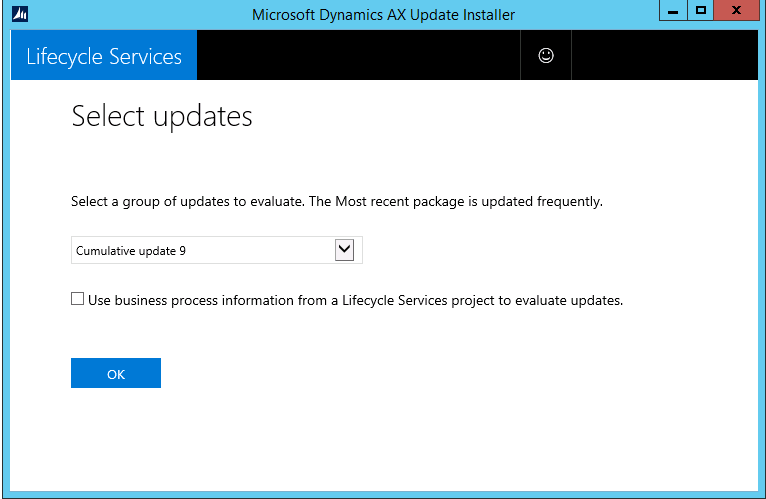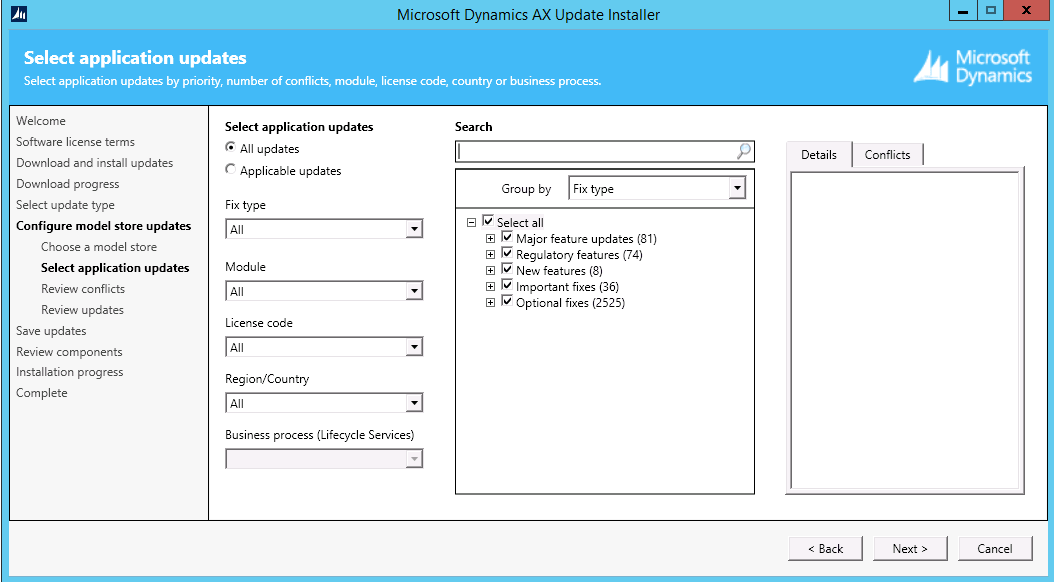The difficulty of installing cumulative updates depends on how much customisation was done in the Client system. The relationship is quite easy: the more customisation, the harder it is, and the more time required to investigate and test issues.
Introduction
One of the most important things is to have a code freeze for the whole process of the upgrade. This is to prevent the developing and testing of new functionality on code from before the upgrade process.
We can divide the upgrade process into three main parts:
- Install upgrade on development or test environment - this is to allow developers to check code conflicts between the cumulative update and currently used code. This step takes most of the upgrade process time and is described in this article.
- If you are using TFS Build environment or any environment in the middle between Development and Live you should also upgrade them before upgrading the Live environment. This is similar but easier than upgrading Live, so you can refer to the article about installing on a Live environment for this.
- Install upgrade on Live environment - this is after all tests are finished and we are happy to start working on the environment. This point is relatively quick, but it will still require several hours to finish, so I suggest doing it during a holiday so as to not disturb business processes in the company. This is described in part 2 of the article.
I always suggest doing Rehearsals before going Live with big changes. It allows you to check if everything was planned correctly, and whether some additional points are required etc. An additional advantage of a rehearsal is that we can measure time spent on the upgrade process. This will allow us to estimate how much time installing the upgrade on Live should take.
Useful documents
- Cumulative Update 9 Installation Guide for Microsoft Dynamics AX 2012 R3 (CU9). Download from http://go.microsoft.com/fwlink/?LinkId=613553.
- Video on Youtube with installation guide: https://www.youtube.com/watch?v=gNg3pHWxoik.
Pre-installation
Step 1
Download CU9 upgrade file. Details can be found in Cumulative Update 9 Installation Guide for Microsoft Dynamics AX 2012 R3 (CU9).
Step 2
Backup data and model databases from the version of environment we want to use in the upgrade.
Step 3
Restore Live databases for CU9_Upgrade environment:
- Live data database into CU9_Upgrade data database environment.
- Live model database into CU9_Upgrade model database environment.
- Live model database into CU9_Upgrade baseline database environment - this is important because Dynamics AX uses it to compare models before and after installation to search for conflicts.
Step 4
For CU8, install Report Viewer 2012 RunTime in case it is not already installed as this is a prerequisite to install AOS, Client, Components, Set up and Support files. Download from http://www.microsoft.com/en-us/download/details.aspx?id=35747.
Step 5
For CU8 uninstall Visual Studio 2010 Tools from Dynamics AX server.
Step 6
Extract files from downloaded packages.
Step 7
Be sure that you have a code freeze for the upgrade process.
Installing update
Step 1
Stop AOS.
Step 2
Start C:\CU9 setup\axupdate.exe.
Step 3
Click Next.
Step 4
Click Accept and continue.
Step 5
Select one of the options:

- Download and install updates if you do not have the package prepared.
- Install updates if you have the package prepared and go to step 7.
Step 6
Log in to LCS and select Cumulative update 9 and wait for download to finish.

Step 7
Select update type you want to make:
- Binary updates.
- Application updates.
Step 8
Select model store where upgrade should be installed.
Step 9
Select applications updates to install and click Next.

Step 10
In Review conflicts tab you have the ability to export them to Excel. Click Next.
Step 11
In Review updates tab click Next.
Step 12
Click Save custom update package button - this package will be used in the Live upgrade process, so be sure to store it in a safe place.
Step 13
Select Install updates on this computer. Click Next.
Step 14
In Review components tab you can select which components you would like to update. Click Next.
Step 15
Click finish.
Post installation
Step 1
Reinitialize model store using one of the options:
AXUtil
- Start Command Prompt.
- Write “axutil schema” and enter.
Microsoft Dynamics AX 2012 Management Shell
- Start Microsoft Dynamics AX 2012 Management Shell.
- Write Initialize-AXModelStore.
Step 2
Compile Dynamics AX using AxBuild.
Step 3
Start AOS.
Step 4
Be sure to check if the Installed models version and Dynamics AX kernel version are correct.
Step 5
I suggest doing a backup here - optional.
Step 6
Complete Software Update checklist up to the point Detect code upgrade conflicts.
Step 7
To find correct code conflicts you need to do it in a development workspace:
a)
Tools -> Code upgrade -> Configure rules for code upgrade.

b)
Click Manage code upgrade rules and select file “Microsoft.Dynamics.AX.Framework.Tools.CodeUpgradeTool.Rules.dll” located in AX client\bin directory. Commonly it is in “C:\Program Files (x86)\Microsoft Dynamics AX\60\Client\Bin”.
c)
Tools -> Code upgrade -> Detect code upgrade conflicts.
d)
Tools -> Code upgrade -> Estimation report.
Step 8
Fix code errors and conflicts.
Step 9
Continue with Software Update checklist.
Step 10
For reports in Dynamics AX 2012 R3 CU8 to be working correctly be sure to:
- Update report viewer on the sql server.
- Create client config and save in report server bin folder: https://technet.microsoft.com/EN-US/library/hh389774.aspx.
- Restart SSRS service.
Step 11
Start testing.
Step 12
After tests are finished and we are happy to go live, export modelStore file with all fixes to use in the Live upgrade process - this is the reason we copied the databases from the Live environment in Pre-installation steps:
- Run command prompt – in run/search field write cmd.
- Write cd <path to AX your server folder> for example: cd “C:\Program Files\Microsoft Dynamics AX\60\Server\MicrosoftDynamicsAX\bin”.
- Write axutil exportstore /file:C:\Users\administrator\Documents\upgradeCU9.

